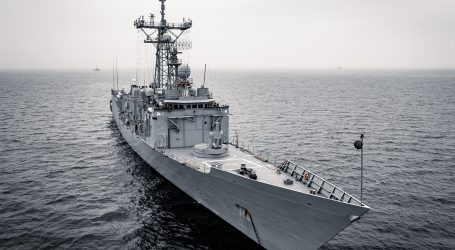– My Heron started out as a six-inch by two-inch sketch, so seeing it on such a grand scale on a BC Ferries’ vessel is amazing – says Penelakut First Nation artist Maynard Johnny Jr.
It’s the first time Johnny Jr, whose Indigenous name is Thii Hayqwtun, has seen his masterpiece on a ship-sized canvas. The wings, tail and beak of Johnny Jr’s Salish Heron are essentially the sizes of a seven-storey building laid on its side and replicated around the expansive hull of the ship. It leaves a massive impression, not just for him but for his family too, who were on hand at BC Ferries’ Fleet Maintenance Unit in Richmond for a private viewing before the vessel goes into service this Spring.
– I’m hoping that my daughter and grandchildren will see the Salish Heron and know that you can achieve something special when you put your mind to it – adds Maynard Johnny Jr. – When they see my art on such a grand scale, I hope they’re influenced by it and have the ambition to chase their goals. I’ve always wanted to influence my daughter and grandchildren to move forward in a positive way.

It’s not an arduous journey from Maynard Johnny Jr.’s Duncan studio to the canvas of his latest creation in Richmond, but the distance doesn’t tell the story. The Heron represents nearly three decades of dedication to the Coast Salish style. The time, patience, and energy to master the two-dimensional design helped separate him from 36 other candidates who were vying for the opportunity to create the Salish Heron piece.
Maynard Johnny Jr. drew inspiration for the herons’ art, which resides throughout the west coast. Traditionally the birds have been guides to where the fish were abundant, so Johnny Jr. used his signature style to create something that would honour Coast Salish’s relationship with the Salish Sea. The ferry is scheduled to enter service in the Southern Gulf Islands in the Spring.
– The idea is to send a message to the people of British Columbia, Canada and the world that Indigenous People have been here since time immemorial – says Johnny Jr. – That’s the message I want to share with people travelling on the Salish Heron. Introducing the Salish Heron and three other Salish ferries with Indigenous art to the BC Ferries fleet is a step forward. It’s a small step, but every step counts.
Salish Heron is the fourth Salish class vessel bestowed with Indigenous art. The name and artwork honour and recognize the Coast Salish as the original mariners of the Salish Sea and represents both the land and culture of British Columbia and the west coast travel experience. The Salish Heron is identical to the three Salish Class ferries designed and built at Remontowa Shipbuilding in Gdansk, Poland, for BC Ferries in 2016, capable of carrying at least 138 vehicles and up to 600 passengers and crew.
The last ferry in the series left the Polish yard on 22 December 2021, without artwork on the sides, sailing a distance of more than 10,400 nautical miles en route to Canada. The voyage route took her through the Atlantic Ocean, the Panama Canal and along the western Pacific coast of North America to Victoria’s Ogden Point. She will soon be operating out of the Southern Gulf Islands in British Columbia.
Recall that Remontowa Shipbuilding delivered the vessels in 2016-2017: Salish Orca, Salish Eagle and Salish Raven, whose sides were also decorated with Indigenous-inspired artwork.
They were the first ferries in the BC Ferries fleet to be LNG-powered and among the first of their kind in North America. Thanks to the innovative propulsion, the vessels emit up to 25 per cent less carbon dioxide, more than 85 per cent fewer sulphur oxides, 50 per cent fewer nitrogen oxides and 99 per cent fewer particulates than propulsion fed by conventional marine fuel.

These are some of the most innovative ferries in the world in this class, entirely designed by Remontowa Marine Design & Consulting and built with the contribution of the Remontowa Holding Group companies. These ferries can be bunkered directly from a wheeled LNG road tanker, entering the vessel’s internal closed deck. This solution allows for this operation in harbours with no land infrastructure for storing and bunkering LNG.
source: BC Ferries/PortalMorski.pl




